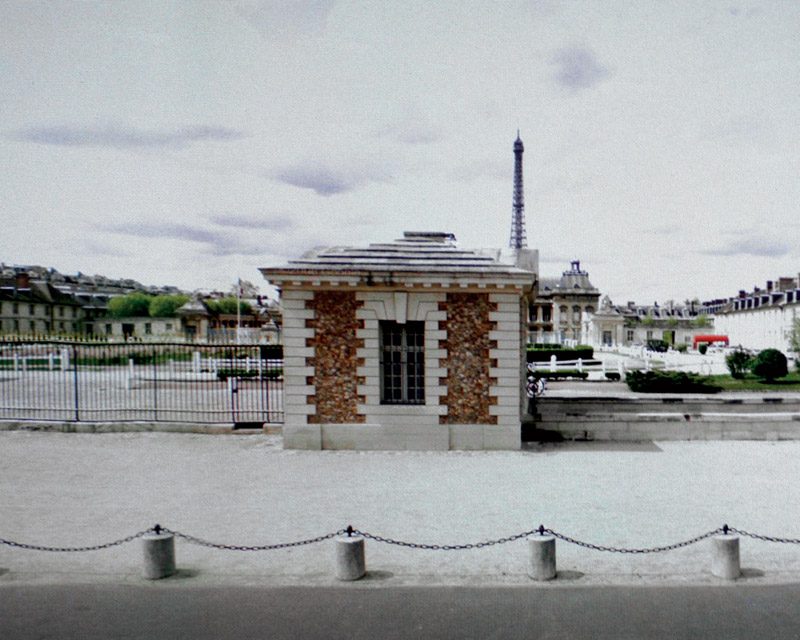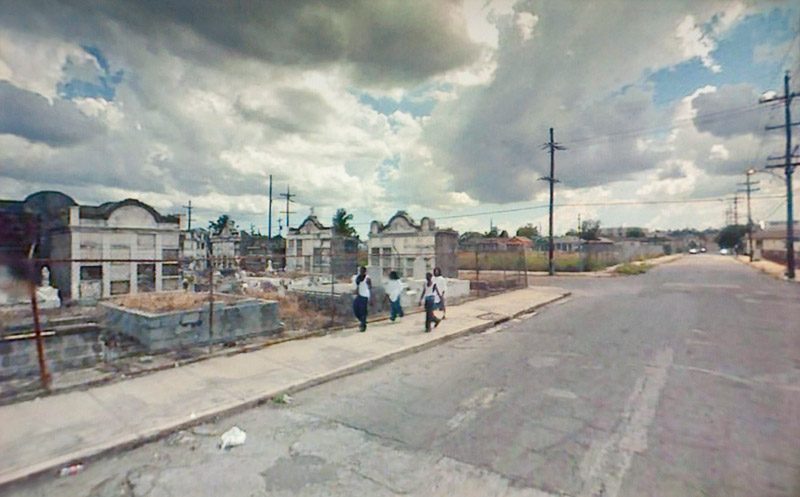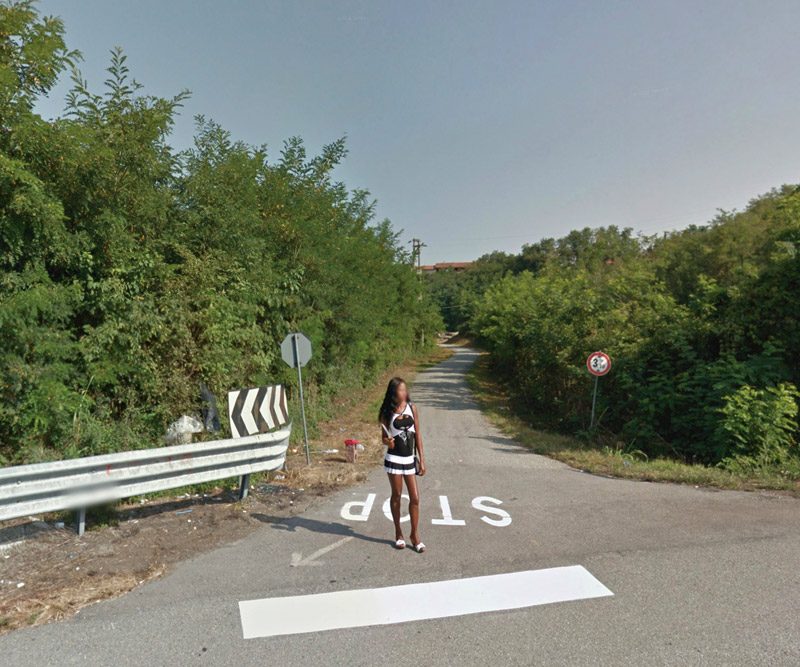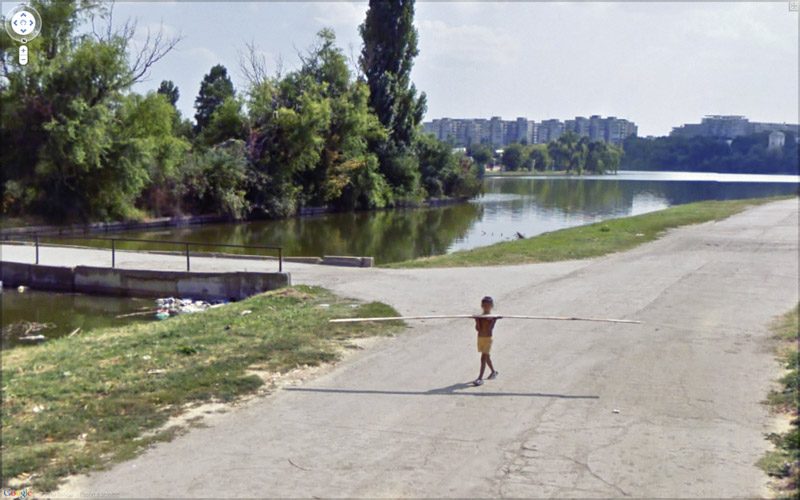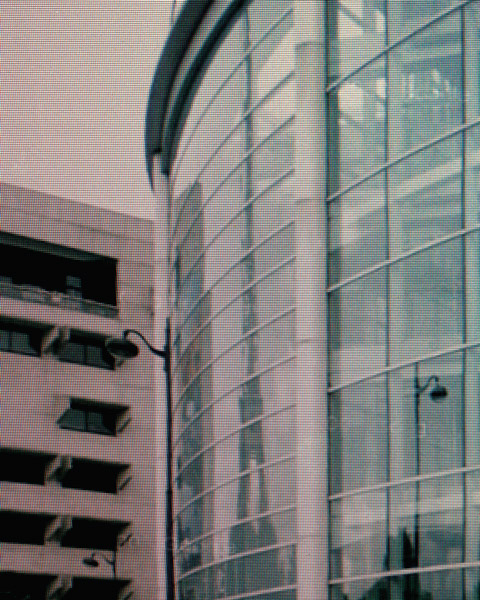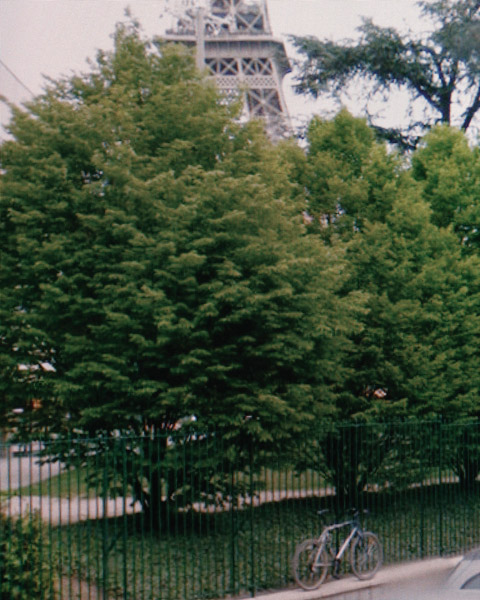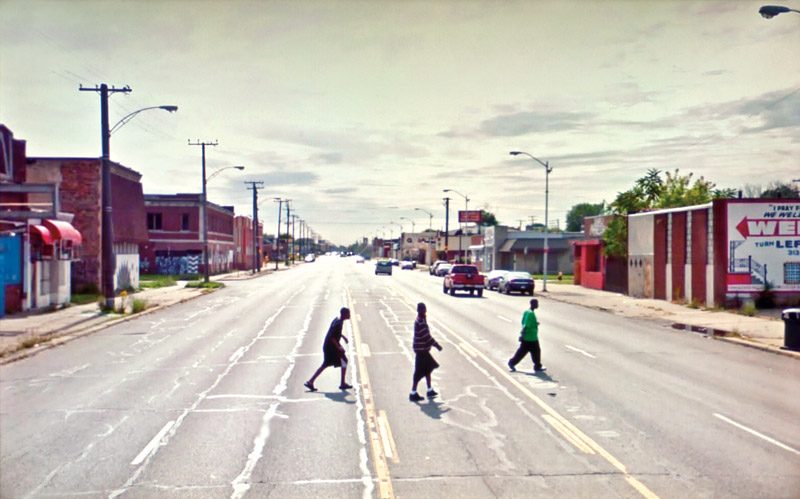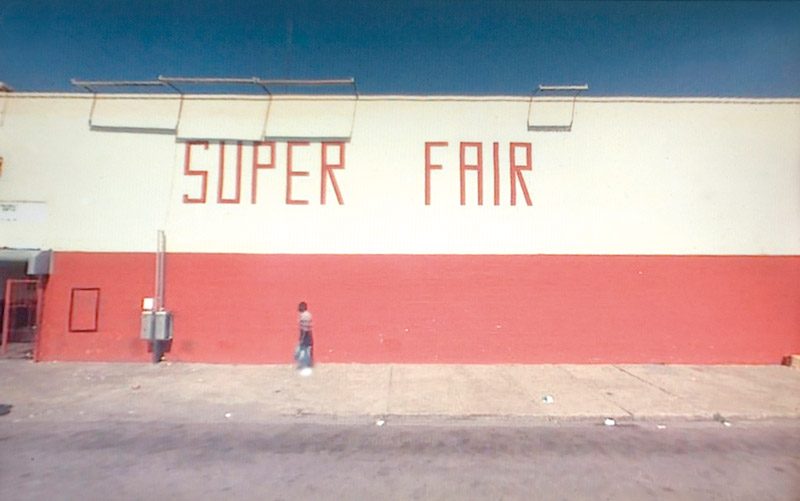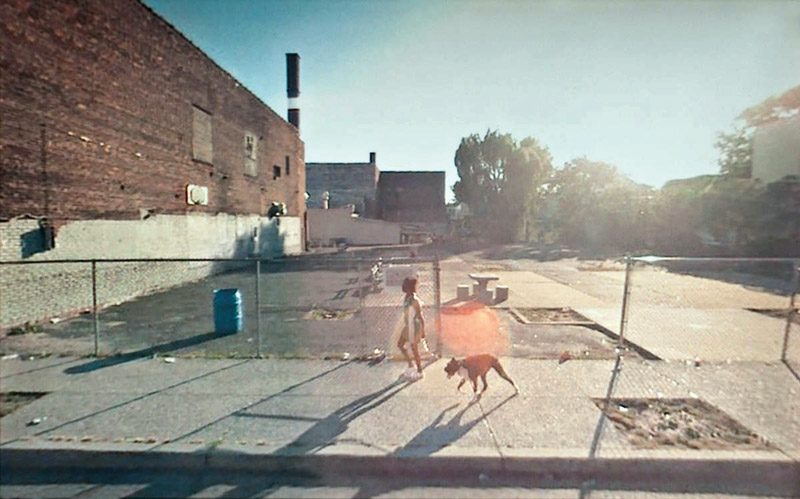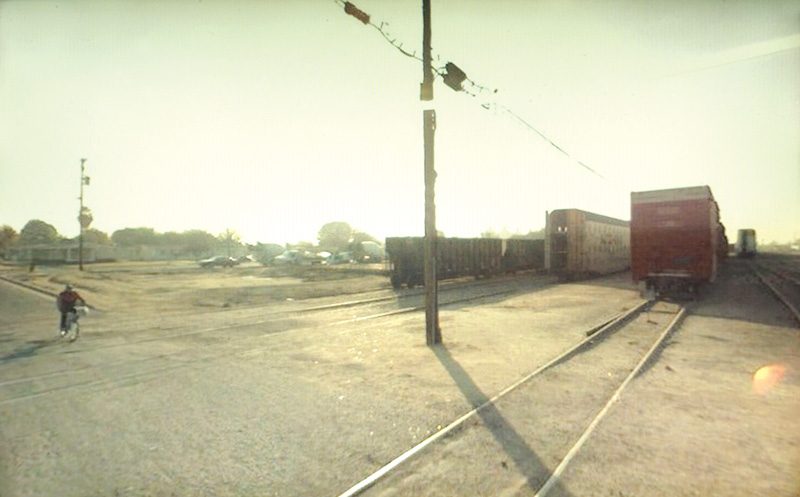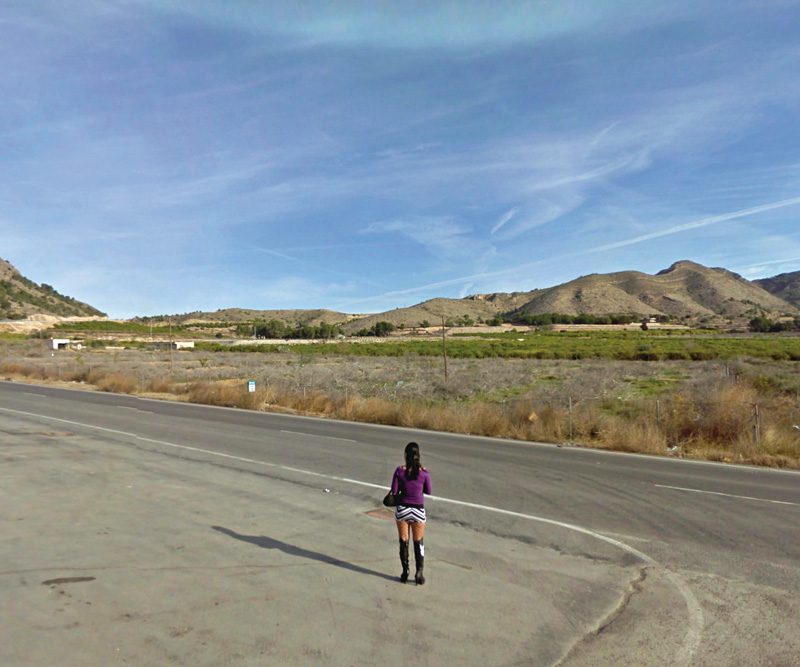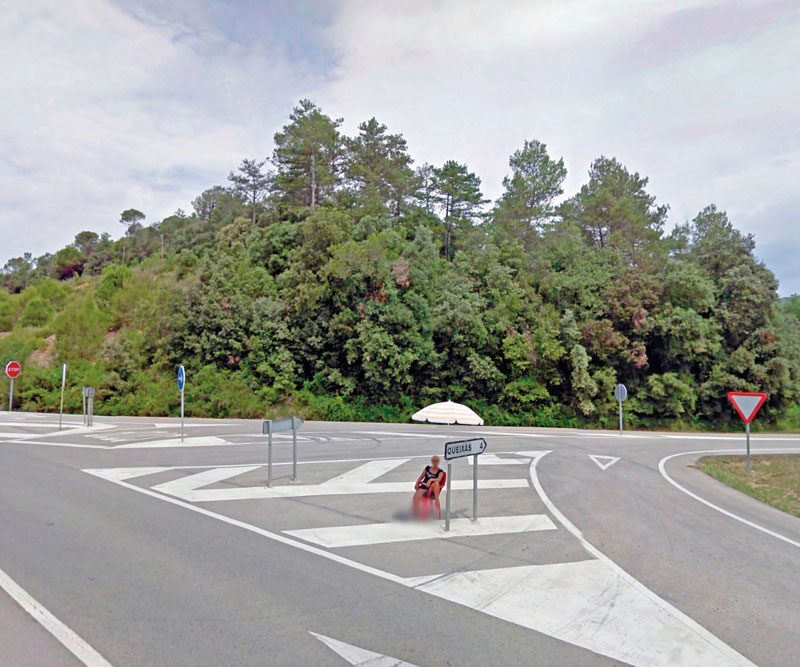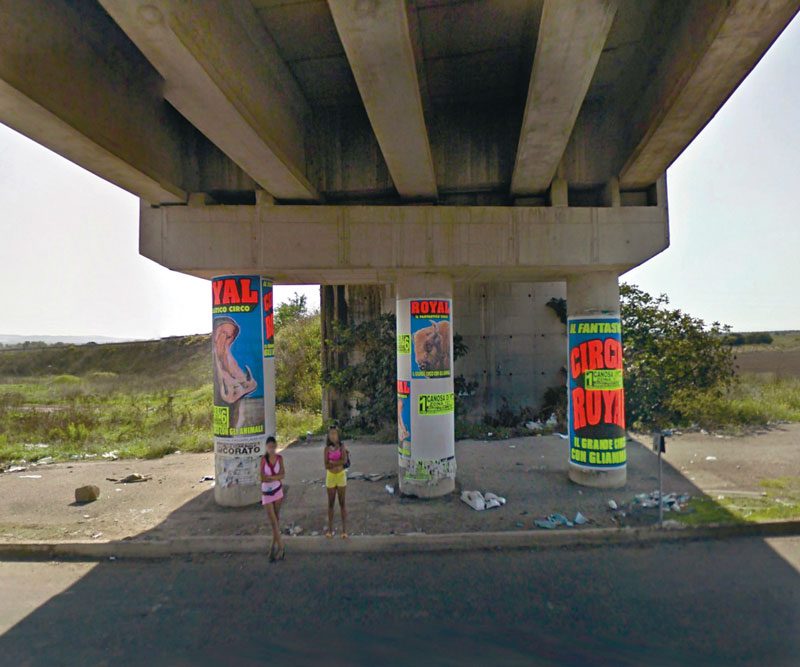By Sylvain Campeau
It has been a few years now since artists discovered that they could put Google Street View to artistic and critical use. The best-known case is no doubt Jon Rafman, who is pursuing – inexorably, I might be tempted to say – his 9-eyes1 project, for which he shamelessly pillages the Internet image bank that contains pictures taken by directional cameras affixed to Google Street View (GSV) cars travelling the roads of various countries and taking photographs at regular intervals. But Rafman isn’t the only one who has taken advantage of the existence of this apparatus. Caroline Delieutraz (from France), Michael Wolf (from Germany), Doug Rickard and Aaron Hobson (from the United States), and Mishka Henner (from Belgium) are among the artists who have taken an interest in exploiting the possibilities offered by GSV.
The operating mode of photography is well known. It has provided the fodder for many artistic explorations. The act of photographing is the result of a co-presence of the object seen and the photographer. As the reproduction of a state of being of the world, it testifies to a capture in real time. It is obviously this essential aspect that is disrupted by taking recourse to the apparatus of delegation that the Internet allows in this particular case. That which has been captured was already mediated, so much so that in this respect the Web is clearly a sort of prosthetic extension of photography – an extension that challenges how any experience of the world can be had today. The Web literally brings photography and GSV together. But can we say that there’s not much left of photography, as the automation made possible by the computer renders any real camera pointless? Of course, there does remain a virtual machinery that borrows its characteristics from the medium, but everything happens a bit as if the digital camera that is the computer has swallowed up photography so completely that it has come to replace, by taking inspiration from, the capture mechanism. Photography has become a virtual act, relayed and executed through cybernetic binary code. But in doing this, it has reinforced its nature as act. Through the prostheses that the Web user–artist uses to compose his or her work, capture and découpage still work. The shot is now all that seems to remain, all that is still operative, in that which photography has bequeathed to cybernetics.
It’s a bit as if photography has become the ghost in the machine, vaguely spectral and always active, but with a time lag, like a forgotten process for which the steps to follow have been preserved. It is as if, both due to it and without it, the Internet and GSV have become partners in the systematic, self-regulated systematic documentation that they perform.
All of this feeds into Rafman’s work. It is from his position, cloistered at his screen, that the capture operation has already been performed by computer and the image comes to us – vaguely anonymous images, “created” by an immobile operator. Onto the apparent banality of the images is superimposed the convenience (I almost wrote, the laziness!) of the operation, as any of us could have been this artist of the capture. We know this position; this image might have appeared on our screen. We are all a keystroke away from accessing Google Maps and Google Street View. We are all, potentially, this operator, this photographer who didn’t have to do much to capture this image – for which he didn’t even have to be a photographer. In fact, as I’ve said, photography has been swallowed up, the cybernetic order has appropriated a large part of its operative model.
But this is exactly what is fascinating in this undertaking. To the actual co-presence of the photographer and the scene that he depicts, to the actual contact that the photosensitivity of chemical materials makes it possible to reproduce, 9-Eyes has preferred the distant overview, the global vision of the Internet, authorized and made possible by its system of infinite relays. To this phenomenon of appropriation/disappearance/survival of computer-assisted photography is added the infinite teleportation of the gaze enabled by the Internet and GSV. For the artist, all that is left is to undertake a long and patient surveillance, an applied navigation, in order to come upon the scene worth retaining and conserving – which becomes, through this selection and printing out on paper, a singular artwork. For one cannot look at Rafman’s images without thinking of the operations through which this image has become that artwork, how this has occurred given that it already existed, a presence latent in the mass of infinite navigation and repeated, yet inert, captures.
Michael Wolf works differently. As is easily observed from their visual rendering, his images are photographed from the screen of his computer. Far from being scenes as complete as those by Rafman, who privileges a wider shot, Wolf offer tighter framings, in slightly high-angle views that bear the imprint of the GSV ambulatory mechanism. They show passers-by, in medium or half-length shots, whose identity is protected by facial blurring. This way of doing things was inspired by his move to Hong Kong, where he was known for his photographs of architectural structures taken in this city under constant construction. In Paris, where he could not hope to find similar urban-development upheavals, he needed a different approach, which he found with GSV.
Wolf is not shy to retouch his images. People sometimes overlap and occupy the space in highly unlikely proportions and scale relations. Some shots resemble stolen images, taken clandestinely from a high perch occupied by an image sniper. Furthermore, the famous virtual navigation arrows, white lines giving directions, street names, red localizers shaped like upside-down teardrops, and sometimes even the pointer appear, suggesting itineraries that we cannot follow. It is thus a sort of enhanced street photography that is the object of photographic investigation here, blended with shots inspired by Henri Cartier-Bresson’s aesthetic of the decisive moment. But it is as if these streets are now of little interest. The French master sought the shot that would give a glimpse of a sort of unexpected event, provoked by a fortuitous encounter in time and space. But today, everything can be seen and captured by everybody; living beings and things have taken on a sort of patina produced by the jaded eyes that gaze at them. All it takes to convince of this is to look at the images in the Eiffel Tower series, in which the structure appears in a distant background, made invisible by the banal foregrounds.
Doug Rickard has chosen to strip from his images all clues that could reveal the source of the borrowing. His eye is sharper in the series A New American Picture, in which he takes a close look at regions, cities, and sites struck by unemployment and poverty. In this, he takes up photography’s mission of social activism championed by his predecessors. The disintegration of living environments, both urban and rural, is at the core of his work, as he follows in the footsteps of Robert Frank, Walker Evans, William Eggleston, and photography of a social nature. He, too, captures images from his computer screen, but he reworks them, carefully erasing all signs associated with Google Street View and Google Map. A few traces of the original mechanism remain, however – discernible in a certain distortion of the image, due to the wide angle, and a sort of blurry granularity that smooths out the detail under a bright colour, reminiscent of some of Edward Hopper’s paintings. This smoothing out of all reference to the native process for these images has given rise to concerns about the legitimacy of the pictures. It is obvious that the photographer has appropriated the result of mechanical captures. Like the other artists, but perhaps even more pointedly, his work resides in selection and découpage, the operations through which he creates artworks and images. Whereas the classic photographer cut into the flesh of the world and the visible to make images, the artists presented here make a selection from a reserve of raw images already made but kept latent. Their number, multiplied by a process of repeated shots, keeps them in an undifferentiated state from which they are awakened only by the intrusion of these artists.
There is another layer to this undertaking, as certain critics have hastened to note. They have posited that William Eggleston’s “democratic camera” has found its continuation in Rickard’s project; Rickard extends its range through the undiscriminating omniscience wrought by Google apparatuses. I imagine that this is a slightly surprising interpretation, given that technological innovations and the unusual uses that certain artists make of them can give rise to an apologetic and exhilarating discourse.2 In any case, the accumulation of images generated automatically by constant ambulatory movement is not a probative scientific guarantee.
The work of the Belgian artist Mishka Henner has created a greater stir. It must be said that Henner excels at putting his finger on thorny subjects, turning squarely to other sources of compilation of public images. For instance, he has used images made by satellites and put online by NASA to expose secret installations such as American military bases and sites deemed sensitive by the Dutch government.3 However, the project that has drawn the most ink is no doubt No Man’s Land, in which images were extracted from online forums for sharing information on the location of sex workers in Spain and Italy. In the images we see women with their faces blurred, but in suggestive poses and clothes, waiting at crossroads – most of them rural. Henner added to this series a video sequence that places us in the position of a potential customer, enabling us to travel in image-by-image sequences, with matching Google indicators, to some of the prostitutes. The images were first grouped in a book that the photographer could design upon request of clients. Few copies were sold. Then the project went viral and the images began to appear on all sorts of websites, in magazines, and on photography blogs. After that, a group of feminist sex workers wanted the book banned; they accused the artist of exploiting the women portrayed and putting them in danger with this public display. The photography world, not to be outdone, expressed its outrage about the project, which it deemed immoral and unethical. This reaction was based on the absence of the photographer; real contact with his subjects, it was argued, would have given rise to empathy that all of his images lacked. And so the book became a phenomenal success. Then, a second book, with new images, was published and nominated for the Deutsche Börse Photography Prize. The critics raved . . . and the book was nowhere near as successful.
This series of contradictory reactions is interesting in itself. We are indignant to see a photographer exploiting an outrageous resource but not at the existence of this resource. We condemn a practice not for the workmanship of the images, but for how they were taken, although this isn’t really visible in the final result. This points out how much the medium used as intermediary has a scope that changes the game. Jean-Paul Fourmentraux, in his essay titled Art et Internet. Les nouvelles figures de la création,4 indicates how, and how much, this third medium – the computer – is an active participant in all art creation. In Pierre Morelli’s opinion, given in a critical note on the subject of that essay, Fourmentraux adheres to the principle of communication advanced by Edmond Couchot,5 which is that “online technological mechanisms offer interlocutors the conditions of a semantic co-construction, which constitutes – in my view – a specific aspect of artworks proper to Net art”6 and, possibly, to all forms of artistic creation involving digital technology. Such a view exemplifies the influence of digital technology on other – but similar – media such as video, photography, and audio. The resulting artwork is conditioned by digital technology, which has swallowed up and supported the other media. The specificity and singular operative model of digital technology are thus found in its absorption of the conditions of technical possibilities and the operational pragmatism of the other media. The meaning of Henner’s work resides in this translation, perfectly illustrated by the cases of use of GSV and the turnkey transmission of operations usually accomplished by the medium absorbed, effecting, in a way, a simplified updating of these unique possibilities. The identity and the work proper to digital technology are in this transfer and this accessibility to the greatest possible number. The artist plays with these to produce his work, which has become a shared act – whence the ensuing ethical confusion, residing in an associative emulation phenomenon. This artwork is the result of an act that I might haveperformed, that any of us might have performed, and it seems equal, in ethical value, to the use of online forums for the purpose of sexual clientelism.
This is manifested in the democratic jubilation aroused by Rickard’s work and the ethical indignation provoked by Henner’s works; the digital technology complements the dimension of the act assumed by photography and virtually offers this possibility to all Internet users, as Rafman suggests. We therefore cannot address these works without evoking the mirage of the possibility that I, the active spectator, can make the image that I see appear, either by having conceived it or by having ultimately achieved it in a gesture that complements the artist’s original effort.
Translated by Käthe Roth
Sylvain Campeau has contributed to Canadian and European magazines (Ciel variable, ETC, Photovision, Inferno). He is also the author of the essays Chambre obscure : photographie et installation, Chantiers de l’image, and Imago Lexis. Sur Rober Racine, as well as five books of poetry. As a curator, he has organized some thirty exhibitions presented in Canada and abroad.
2 I will temper this impetus by recalling that in April 2015 the European Commission accused Google of abuse of its dominant position in online searching to have highlighted its services to the detriment of those of the competition. See ici.radio-canada.ca/nouvelles/economie/2015/04/15/002-google-union-europeenne- enquete-concurrence.shtml.
3 The images of royal palaces, fuel storage tanks, and army barracks were therefore censored by overprinting polygonal blocks in multiple colours over the problematic sites. Censorship, O how artistic! And of which Henner made art!
4 Jean-Paul Fourmentraux, Art et Internet. Les nouvelles figures de la création (Paris: CNRS, 2005).
5 Edmond Couchot, La technologie dans l’art. De la photographie à la réalité virtuelle (Nimes: J. Chambon, 1998).
6 Pierre Morelli, “Jean-Paul Fourmentraux, Art et Internet. Les nouvelles figures de la création,” Questions de communication no. 14 (2008), put online March 21, 2012, accessed April 16, 2015, questionsdecommunica tion.revues.org/1664 (our translation).


